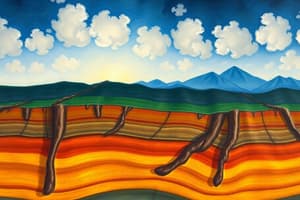Podcast
Questions and Answers
What happens at divergent boundaries?
What happens at divergent boundaries?
- Plates collide and create mountains.
- Plates sink into the mantle.
- Plates slide past each other.
- Plates move apart and create new crust. (correct)
The theory of continental drift was widely accepted immediately after it was proposed.
The theory of continental drift was widely accepted immediately after it was proposed.
False (B)
What is the main function of convection currents in the Earth's mantle?
What is the main function of convection currents in the Earth's mantle?
To drive plate tectonics.
At convergent boundaries, oceanic crust is generally ______ than continental crust.
At convergent boundaries, oceanic crust is generally ______ than continental crust.
Which geological feature is typically formed at convergent boundaries involving oceanic crust?
Which geological feature is typically formed at convergent boundaries involving oceanic crust?
Match the internal layers of the Earth with their characteristics:
Match the internal layers of the Earth with their characteristics:
Seafloor spreading occurs at transform boundaries.
Seafloor spreading occurs at transform boundaries.
Who proposed the theory of continental drift?
Who proposed the theory of continental drift?
The process of ______ involves magma rising to create new oceanic crust.
The process of ______ involves magma rising to create new oceanic crust.
What type of plate boundary is characterized by plates sliding past each other?
What type of plate boundary is characterized by plates sliding past each other?
Flashcards
Plate Tectonics
Plate Tectonics
The theory describing how Earth's lithosphere moves.
Divergent Boundaries
Divergent Boundaries
Plates moving apart, creating new crust.
Convergent Boundaries
Convergent Boundaries
Plates colliding, forming mountains or trenches.
Transform Boundaries
Transform Boundaries
Signup and view all the flashcards
Seafloor Spreading
Seafloor Spreading
Signup and view all the flashcards
Convection Currents
Convection Currents
Signup and view all the flashcards
Continental Drift
Continental Drift
Signup and view all the flashcards
Earth's Crust
Earth's Crust
Signup and view all the flashcards
Earth's Mantle
Earth's Mantle
Signup and view all the flashcards
Plate Boundary
Plate Boundary
Signup and view all the flashcards
Study Notes
Plate Tectonics
- The theory of plate tectonics describes the large-scale motion of Earth's lithosphere.
- Earth's lithosphere is broken into several large and small plates that move relative to each other.
- These plates are constantly interacting at their boundaries, resulting in various geological phenomena.
Types Of Plate Boundaries
- Divergent Boundaries: Plates move apart, creating new crust. Magma rises to the surface, forming volcanoes and ridges. Examples include mid-ocean ridges and rift valleys.
- Convergent Boundaries: Plates collide. The type of interaction depends on the plate types (oceanic vs. continental). Oceanic crust is generally denser and can be subducted, leading to volcanic arcs or deep trenches. Continental crust is less dense and typically does not subduct, resulting in mountain ranges.
- Transform Boundaries: Plates slide past each other horizontally. Friction creates earthquakes along faults, like the San Andreas Fault.
Theory Of Continental Drift
- Proposed by Alfred Wegener, this theory suggested that continents were once joined in a supercontinent (Pangaea) and have since drifted apart.
- Evidence included the fit of continents, distribution of fossils, and matching rock formations on different continents.
- The theory was initially rejected due to a lack of a mechanism to explain the movement of continents.
Seafloor Spreading
- This process occurs at divergent boundaries. Magma rises from the mantle, creating new oceanic crust along mid-ocean ridges. The newly formed crust pushes older crust to the sides, widening the ocean basin.
- The process provides evidence for the movement of plates.
- Magma emerges from the Earth's mantle, cools, and solidifies into new crust.
Convection Currents
- Convection currents are circulatory movements within the Earth's mantle.
- These currents are driven by differences in temperature and density within the mantle.
- Warmer, less dense material rises, while cooler, denser material sinks.
- This movement plays a crucial role in driving plate tectonics.
Interior of Earth
- Earth's interior consists of layers with varying physical and chemical properties:
- Crust: The outermost, relatively thin layer, composed of solid rock.
- Mantle: A thick layer beneath the crust, mostly solid rock but may exhibit some viscous flow. Its composition is largely silicate minerals.
- Outer Core: A layer of molten iron and nickel.
- Inner Core: A dense, solid ball of iron and nickel.
- The different layers interact through convection currents within the mantle, impacting plate movement. These differing densities and viscosities are essential for the process of plate tectonics to occur.
Studying That Suits You
Use AI to generate personalized quizzes and flashcards to suit your learning preferences.




